Kexin Chen
Rethinking Benign Overfitting in Two-Layer Neural Networks
Feb 17, 2025Abstract:Recent theoretical studies (Kou et al., 2023; Cao et al., 2022) have revealed a sharp phase transition from benign to harmful overfitting when the noise-to-feature ratio exceeds a threshold-a situation common in long-tailed data distributions where atypical data is prevalent. However, harmful overfitting rarely happens in overparameterized neural networks. Further experimental results suggested that memorization is necessary for achieving near-optimal generalization error in long-tailed data distributions (Feldman & Zhang, 2020). We argue that this discrepancy between theoretical predictions and empirical observations arises because previous feature-noise data models overlook the heterogeneous nature of noise across different data classes. In this paper, we refine the feature-noise data model by incorporating class-dependent heterogeneous noise and re-examine the overfitting phenomenon in neural networks. Through a comprehensive analysis of the training dynamics, we establish test loss bounds for the refined model. Our findings reveal that neural networks can leverage "data noise", previously deemed harmful, to learn implicit features that improve the classification accuracy for long-tailed data. Experimental validation on both synthetic and real-world datasets supports our theoretical results.
Characterizing and Evaluating the Reliability of LLMs against Jailbreak Attacks
Aug 18, 2024
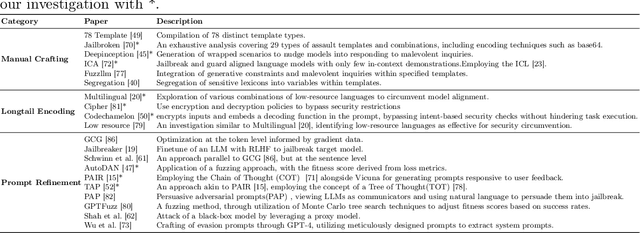
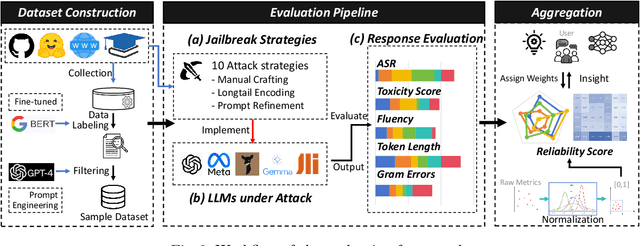

Abstract:Large Language Models (LLMs) have increasingly become pivotal in content generation with notable societal impact. These models hold the potential to generate content that could be deemed harmful.Efforts to mitigate this risk include implementing safeguards to ensure LLMs adhere to social ethics.However, despite such measures, the phenomenon of "jailbreaking" -- where carefully crafted prompts elicit harmful responses from models -- persists as a significant challenge. Recognizing the continuous threat posed by jailbreaking tactics and their repercussions for the trustworthy use of LLMs, a rigorous assessment of the models' robustness against such attacks is essential. This study introduces an comprehensive evaluation framework and conducts an large-scale empirical experiment to address this need. We concentrate on 10 cutting-edge jailbreak strategies across three categories, 1525 questions from 61 specific harmful categories, and 13 popular LLMs. We adopt multi-dimensional metrics such as Attack Success Rate (ASR), Toxicity Score, Fluency, Token Length, and Grammatical Errors to thoroughly assess the LLMs' outputs under jailbreak. By normalizing and aggregating these metrics, we present a detailed reliability score for different LLMs, coupled with strategic recommendations to reduce their susceptibility to such vulnerabilities. Additionally, we explore the relationships among the models, attack strategies, and types of harmful content, as well as the correlations between the evaluation metrics, which proves the validity of our multifaceted evaluation framework. Our extensive experimental results demonstrate a lack of resilience among all tested LLMs against certain strategies, and highlight the need to concentrate on the reliability facets of LLMs. We believe our study can provide valuable insights into enhancing the security evaluation of LLMs against jailbreak within the domain.
Addressing Out-of-Distribution Challenges in Image Semantic Communication Systems with Multi-modal Large Language Models
Jul 22, 2024



Abstract:Semantic communication is a promising technology for next-generation wireless networks. However, the out-of-distribution (OOD) problem, where a pre-trained machine learning (ML) model is applied to unseen tasks that are outside the distribution of its training data, may compromise the integrity of semantic compression. This paper explores the use of multi-modal large language models (MLLMs) to address the OOD issue in image semantic communication. We propose a novel "Plan A - Plan B" framework that leverages the broad knowledge and strong generalization ability of an MLLM to assist a conventional ML model when the latter encounters an OOD input in the semantic encoding process. Furthermore, we propose a Bayesian optimization scheme that reshapes the probability distribution of the MLLM's inference process based on the contextual information of the image. The optimization scheme significantly enhances the MLLM's performance in semantic compression by 1) filtering out irrelevant vocabulary in the original MLLM output; and 2) using contextual similarities between prospective answers of the MLLM and the background information as prior knowledge to modify the MLLM's probability distribution during inference. Further, at the receiver side of the communication system, we put forth a "generate-criticize" framework that utilizes the cooperation of multiple MLLMs to enhance the reliability of image reconstruction.
Transmitter Side Beyond-Diagonal RIS for mmWave Integrated Sensing and Communications
Apr 19, 2024



Abstract:This work initiates the study of a beyond-diagonal reconfigurable intelligent surface (BD-RIS)-aided transmitter architecture for integrated sensing and communication (ISAC) in the millimeter-wave (mmWave) frequency band. Deploying BD-RIS at the transmitter side not only alleviates the need for extensive fully digital radio frequency (RF) chains but also enhances both communication and sensing performance. These benefits are facilitated by the additional design flexibility introduced by the fully-connected scattering matrix of BD-RIS. To achieve the aforementioned benefits, in this work, we propose an efficient two-stage algorithm to design the digital beamforming of the transmitter and the scattering matrix of the BD-RIS with the aim of jointly maximizing the sum rate for multiple communication users and minimizing the largest eigenvalue of the Cramer-Rao bound (CRB) matrix for multiple sensing targets. Numerical results show that the transmitter-side BD-RIS-aided mmWave ISAC outperforms the conventional diagonal-RIS-aided ones in both communication and sensing performance.
LLM-Assisted Multi-Teacher Continual Learning for Visual Question Answering in Robotic Surgery
Feb 26, 2024



Abstract:Visual question answering (VQA) can be fundamentally crucial for promoting robotic-assisted surgical education. In practice, the needs of trainees are constantly evolving, such as learning more surgical types, adapting to different robots, and learning new surgical instruments and techniques for one surgery. Therefore, continually updating the VQA system by a sequential data stream from multiple resources is demanded in robotic surgery to address new tasks. In surgical scenarios, the storage cost and patient data privacy often restrict the availability of old data when updating the model, necessitating an exemplar-free continual learning (CL) setup. However, prior studies overlooked two vital problems of the surgical domain: i) large domain shifts from diverse surgical operations collected from multiple departments or clinical centers, and ii) severe data imbalance arising from the uneven presence of surgical instruments or activities during surgical procedures. This paper proposes to address these two problems with a multimodal large language model (LLM) and an adaptive weight assignment methodology. We first develop a new multi-teacher CL framework that leverages a multimodal LLM as the additional teacher. The strong generalization ability of the LLM can bridge the knowledge gap when domain shifts and data imbalances occur. We then put forth a novel data processing method that transforms complex LLM embeddings into logits compatible with our CL framework. We further design an adaptive weight assignment approach that balances the generalization ability of the LLM and the domain expertise of the old CL model. We construct a new dataset for surgical VQA tasks, providing valuable data resources for future research. Extensive experimental results on three datasets demonstrate the superiority of our method to other advanced CL models.
An Autonomous Large Language Model Agent for Chemical Literature Data Mining
Feb 20, 2024



Abstract:Chemical synthesis, which is crucial for advancing material synthesis and drug discovery, impacts various sectors including environmental science and healthcare. The rise of technology in chemistry has generated extensive chemical data, challenging researchers to discern patterns and refine synthesis processes. Artificial intelligence (AI) helps by analyzing data to optimize synthesis and increase yields. However, AI faces challenges in processing literature data due to the unstructured format and diverse writing style of chemical literature. To overcome these difficulties, we introduce an end-to-end AI agent framework capable of high-fidelity extraction from extensive chemical literature. This AI agent employs large language models (LLMs) for prompt generation and iterative optimization. It functions as a chemistry assistant, automating data collection and analysis, thereby saving manpower and enhancing performance. Our framework's efficacy is evaluated using accuracy, recall, and F1 score of reaction condition data, and we compared our method with human experts in terms of content correctness and time efficiency. The proposed approach marks a significant advancement in automating chemical literature extraction and demonstrates the potential for AI to revolutionize data management and utilization in chemistry.
Towards an Automatic AI Agent for Reaction Condition Recommendation in Chemical Synthesis
Nov 28, 2023



Abstract:Artificial intelligence (AI) for reaction condition optimization has become an important topic in the pharmaceutical industry, given that a data-driven AI model can assist drug discovery and accelerate reaction design. However, existing AI models lack the chemical insights and real-time knowledge acquisition abilities of experienced human chemists. This paper proposes a Large Language Model (LLM) empowered AI agent to bridge this gap. We put forth a novel three-phase paradigm and applied advanced intelligence-enhancement methods like in-context learning and multi-LLM debate so that the AI agent can borrow human insight and update its knowledge by searching the latest chemical literature. Additionally, we introduce a novel Coarse-label Contrastive Learning (CCL) based chemical fingerprint that greatly enhances the agent's performance in optimizing the reaction condition. With the above efforts, the proposed AI agent can autonomously generate the optimal reaction condition recommendation without any human interaction. Further, the agent is highly professional in terms of chemical reactions. It demonstrates close-to-human performance and strong generalization capability in both dry-lab and wet-lab experiments. As the first attempt in the chemical AI agent, this work goes a step further in the field of "AI for chemistry" and opens up new possibilities for computer-aided synthesis planning.
Point-Bind & Point-LLM: Aligning Point Cloud with Multi-modality for 3D Understanding, Generation, and Instruction Following
Sep 01, 2023



Abstract:We introduce Point-Bind, a 3D multi-modality model aligning point clouds with 2D image, language, audio, and video. Guided by ImageBind, we construct a joint embedding space between 3D and multi-modalities, enabling many promising applications, e.g., any-to-3D generation, 3D embedding arithmetic, and 3D open-world understanding. On top of this, we further present Point-LLM, the first 3D large language model (LLM) following 3D multi-modal instructions. By parameter-efficient fine-tuning techniques, Point-LLM injects the semantics of Point-Bind into pre-trained LLMs, e.g., LLaMA, which requires no 3D instruction data, but exhibits superior 3D and multi-modal question-answering capacity. We hope our work may cast a light on the community for extending 3D point clouds to multi-modality applications. Code is available at https://github.com/ZiyuGuo99/Point-Bind_Point-LLM.
The Power of Large Language Models for Wireless Communication System Development: A Case Study on FPGA Platforms
Jul 14, 2023
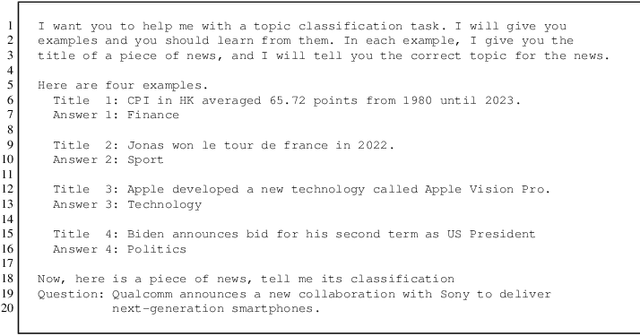


Abstract:Large language models (LLMs) have garnered significant attention across various research disciplines, including the wireless communication community. There have been several heated discussions on the intersection of LLMs and wireless technologies. While recent studies have demonstrated the ability of LLMs to generate hardware description language (HDL) code for simple computation tasks, developing wireless prototypes and products via HDL poses far greater challenges because of the more complex computation tasks involved. In this paper, we aim to address this challenge by investigating the role of LLMs in FPGA-based hardware development for advanced wireless signal processing. We begin by exploring LLM-assisted code refactoring, reuse, and validation, using an open-source software-defined radio (SDR) project as a case study. Through the case study, we find that an LLM assistant can potentially yield substantial productivity gains for researchers and developers. We then examine the feasibility of using LLMs to generate HDL code for advanced wireless signal processing, using the Fast Fourier Transform (FFT) algorithm as an example. This task presents two unique challenges: the scheduling of subtasks within the overall task and the multi-step thinking required to solve certain arithmetic problem within the task. To address these challenges, we employ in-context learning (ICL) and Chain-of-Thought (CoT) prompting techniques, culminating in the successful generation of a 64-point Verilog FFT module. Our results demonstrate the potential of LLMs for generalization and imitation, affirming their usefulness in writing HDL code for wireless communication systems. Overall, this work contributes to understanding the role of LLMs in wireless communication and motivates further exploration of their capabilities.
Rate-Splitting Multiple Access for Simultaneous Multi-User Communication and Multi-Target Sensing
Jun 10, 2023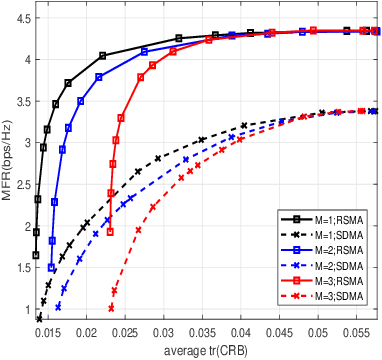
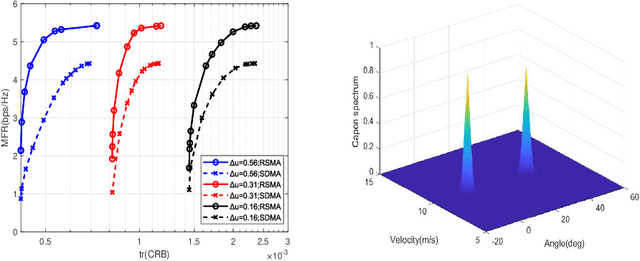
Abstract:In this paper, we initiate the study of rate-splitting multiple access (RSMA) for a mono-static integrated sensing and communication (ISAC) system, where the dual-functional base station (BS) simultaneously communicates with multiple users and detects multiple moving targets. We aim at optimizing the ISAC waveform to jointly maximize the max-min fairness (MMF) rate of the communication users and minimize the largest eigenvalue of the Cram\'er-Rao bound (CRB) matrix for unbiased estimation. The CRB matrix considered in this work is general as it involves the estimation of angular direction, complex reflection coefficient, and Doppler frequency for multiple moving targets. Simulation results demonstrate that RSMA maintains a larger communication and sensing trade-off than conventional space-division multiple access (SDMA) and it is capable of detecting multiple targets with a high detection accuracy. The finding highlights the potential of RSMA as an effective and powerful strategy for interference management in the general multi-user multi-target ISAC systems.
 Add to Chrome
Add to Chrome Add to Firefox
Add to Firefox Add to Edge
Add to Edge